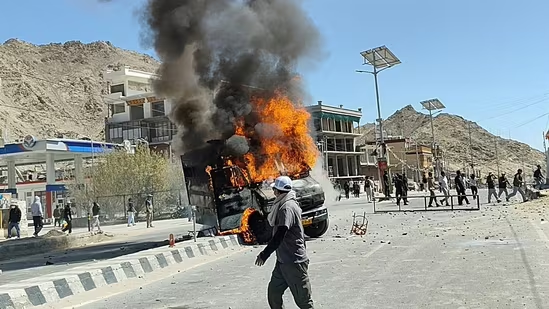Four people died in violent protests in Ladakh as demands for statehood escalated. The BJP claims the unrest wasn’t youth-led or Gen Z-driven, but orchestrated by Congress. Read detailed coverage on causes, claims, and aftermath.

Ladakh Protests Turn Deadly — 4 Killed; BJP Blames Congress, Denies Gen Z Leadership
Introduction
In the Himalayan Union Territory of Ladakh, protests spiraled into violence on September 24, 2025, leaving four people dead and many injured. The agitators were demanding statehood and constitutional safeguards (notably the extension of the Sixth Schedule) amid growing frustration over perceived neglect. While some reports portrayed the movement as a “Gen Z uprising,” the Bharatiya Janata Party (BJP) countered that the protests were not youth-led but instigated by the Congress Party.
This article delves into the timeline, demands, claims & counterclaims, and what lies ahead for Ladakh.
Timeline of Events & Trigger Points
Hunger Strike & Shutdown Call
Activists led by Sonam Wangchuk had launched a 15-day hunger strike demanding statehood and constitutional protections for Ladakh. When two participants’ health severely deteriorated, organizers called for a shutdown and protest rally in Leh.
Escalation to Violence
Protesters gathered at NDS Memorial Ground, marched through Leh’s streets, and reportedly pelted stones at the BJP office, Hill Council building, and police/CRPF vehicles. Security forces responded with tear gas, baton charges, and in some places, live firing.
The clashes led to four protesters’ deaths and dozens injured, including security personnel. Authorities have enforced restrictions and curfews in Leh and Kargil.
Aftermath & Restrictions
- Curfews imposed and prohibitory orders issued under Section 163 BNSS (restricting assembly).
- The annual Ladakh festival was canceled.
- Additional forces deployed and investigations launched.
- Congress councillor Phuntsog Stanzin Tsepag was named in an FIR for alleged involvement in incitement and arson.
Demands & Underlying Grievances
Statehood & Sixth Schedule Inclusion
Protesters are pressing for full statehood and the application of Sixth Schedule protections—rights commonly granted to tribal areas (providing autonomy, financial aid, local governance powers). Wikipedia
Residents cite loss of autonomy, resource exploitation, and lack of local representation since Ladakh’s reorganisation in 2019.
Youth Frustration & Political Engineering
Many younger residents assert that peaceful methods have failed to produce results, leading to rising anger and participation.
But the BJP has countered that what was portrayed as youth-led energy was in fact political engineering by Congress. The party cited video evidence of Congressman-backed councillors leading protest actions.
Meanwhile, Sonam Wangchuk has denied that Congress has the influence to mobilize 5,000 youth in Ladakh.
Premeditation Claims
Officials suggest the violence was planned in advance, pointing to inflammatory statements, timing (before scheduled talks), and coordinated action.
BJP’s Claims vs Responses
BJP’s Position
- The protest was not led by Gen Z youth but orchestrated by Congress cadres.
- They released images/videos of councillor Stanzin Tsepag allegedly instigating attacks at the BJP office.
- The Ministry of Home Affairs (MHA) claimed Wangchuk misled people via references to Arab Spring and Gen Z protests in Nepal.
Counterarguments & Denials
- Wangchuk responded that Congress doesn’t wield such influence in Ladakh to manage large youth mobilizations.
- Analysts and local leaders question the timing of violence just ahead of previously scheduled October 6 talks.
- Doubts remain whether evidence released by BJP conclusively shows leadership roles or mere presence.
What Comes Next — Risks & Remedies
Upcoming Talks & Negotiations
A fresh round of talks between the Centre, Leh Apex Body (LAB), and Kargil Democratic Alliance (KDA) is already scheduled for October 6.
Any progress in these talks will be closely watched by Ladakhi communities, activists, and political parties alike.
Investigation & Accountability
The administration has initiated a probe into the violence, firings, and involvement of political actors.
Who ordered the firings? Who injured or killed protesters? Who instigated the arson? These are the key questions demanding answers.
Risk of Political Polarization
These allegations and counter-allegations may further politicize the agitation, risking a diversion from core demands to blame games. If not handled delicately, youth disenchantment could deepen.
Local Trust & Dialogue
Long-term peace will depend on bridging the trust deficit—giving locals real avenues for participation, ensuring promises turn into action, and keeping national-level politics from overshadowing regional aspirations.
The tragic events in Ladakh mark a turning point for a region long grappling with governance, identity, and autonomy. While demands for statehood and constitutional protection lie at the heart, the question now is: who truly drives the movement? As BJP and Congress exchange accusations over leadership and intent, the real measure of justice will come from meaningful dialogue, accountability, and addressing root grievances.
READ ALSO…….PM Modi’s Agenda Today: Greater Noida UPITS Inauguration & Major Rajasthan Projects Itinerary 2025















 Categories
Categories









